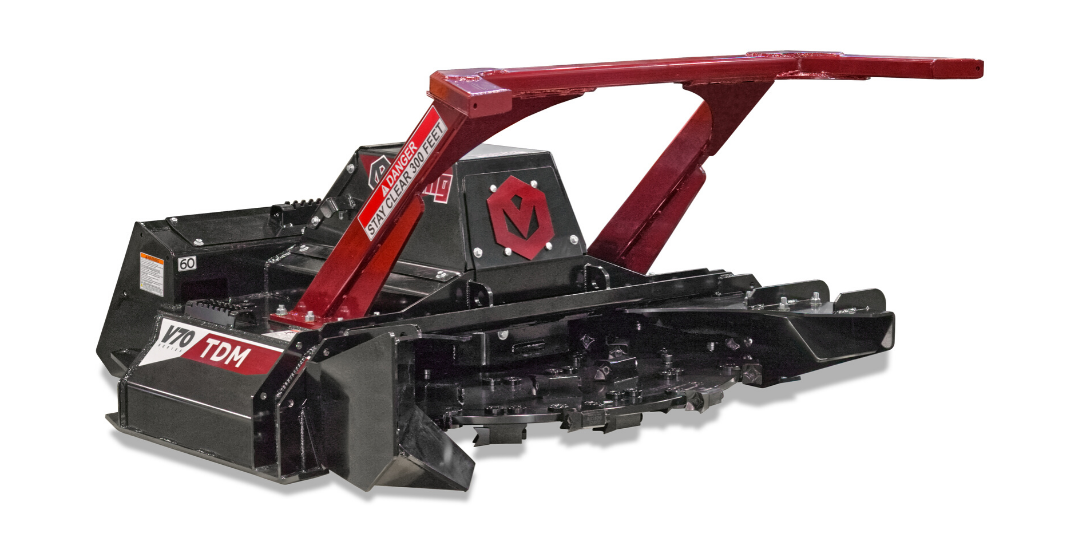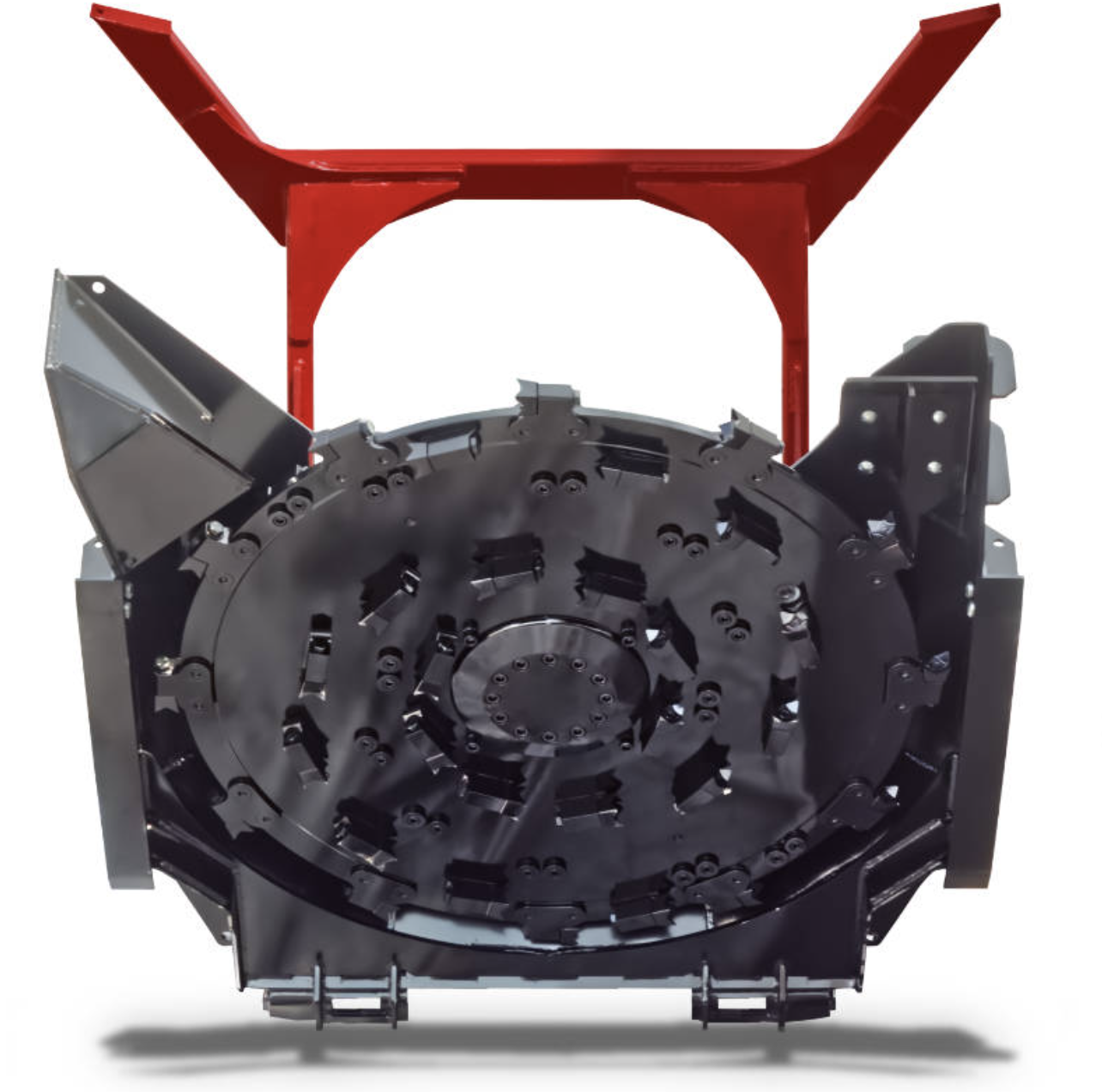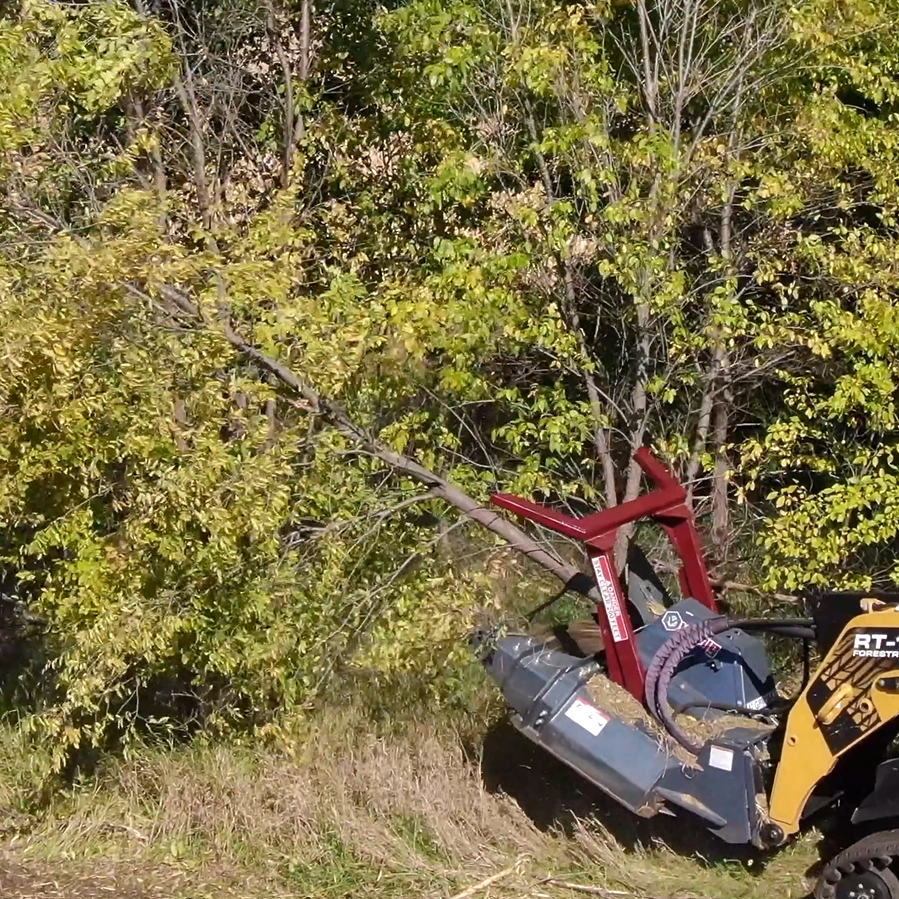A skid steer disc mulcher is a powerful, effective land clearing attachment when matched with a suitable machine. But forestry mulchers can also be hazardous if safety is not prioritized. We'll cover step-by-step how to operate and maintain skid steer mulchers to help keep you safe and productive at your jobsite.
Step 1: Match A DISC MULCHER ATTACHMENT TO YOUR EQUIPMENT
The first step to safe, efficient operation is to ensure a proper match between the skid steer and your mulching attachment. With so many options to choose from, it's important to match the flow rate of your skid steer's hydraulic system.

MATCHING HYDRAULIC FLOW RATE
Most mulcher attachments require a skid steer with high flow hydraulics. You'll need to know the flow rate of your skid steer and the minimum and maximum flow rate of the mulcher.
For example, the Virnig V70 Series Tree Disc Mulcher has a recommended flow rate of 30-45 gallons per minute (GPM), which will require a machine with high flow hydraulics. If a machine’s flow rate is under 30 GPM, the operator may not get the desired performance.
IMPORTANT TIP: To achieve optimal performance, the mulcher’s flow rate should fall within the min/max range of the mulcher motor.
MATCHING LIFTING REQUIREMENTS
Disc mulchers are one of the heaviest skid steer attachments you can purchase. In fact, the disc alone weighs over 900 lbs, as these attachments need to be well built with heavy motors and thick steel to handle the abuse that forestry mulching entails. That means your skid steer needs to effectively handle the weight of the attachment plus the weight of the trees it’s pushing and clearing.
Step 2: BE PROACTIVE, NOT REACTIVE
Disc mulchers are expensive attachments, especially if they aren’t maintained. Be proactive to ensure safe and efficient operation.
“Do daily inspections for damages, leaks, and loose bolts," says Greg Meyer of MTS Tree Service. "Keep teeth sharp to eliminate unnecessary damage to holding components and retain efficiency while cutting."

CLEAN YOUR DISC MULCHER
Every time you connect couplers, there’s a potential chance to add contaminants to the hydraulic system. Some operators learn the hard way that contamination of hydraulic oil can cause motor failure. When connecting hydraulic hoses to the machine, use a clean rag or towel to thoroughly clean all couplers (both machine and attachment) before making connections.
The entire skid steer and forestry mulcher should be cleaned periodically, as debris build-up near the engine can cause the machine to overheat and catch fire. And all windows should be kept clean to provide optimal operator visibility.
When replacing teeth, the disc bolt holes must be cleaned to allow bolts to torque properly. If there's debris in the bolt holes, the bolts may not torque correctly, inviting teeth to loosen and fly off the disc.
EXCESSIVE VIBRATION
If you discover excessive vibration at any point, there could be loose hardware, missing/damaged teeth, or debris stuck on the mulching disc. Debris stuck on the mulching disc may be removed by processing another tree. If the vibration persists, stop and inspect the mulcher for a possible cause. Before exiting the machine, lower the mulcher attachment to the ground, turn off the machine’s engine, and remove the key.
HYDRAULIC TIPS
To minimize the risk of overheating, continuous rotation of the disc is recommended. If the disc stalls completely, disengage hydraulics and remove the disc from the material before restarting.
Be sure to engage hydraulics at an idle. When the disc is rotating smoothly, bring the loader to the engine operating rpm. Remember, don’t engage the disc into the material until the disc is running smoothly at engine operating rpm.
Step 3: Prioritize safety around your DISC MULCHER
While all skid steer attachments should be approached with an understanding of the potential dangers, forestry mulchers should receive extra attention before operating.
MULCHER INJURY & DAMAGE PREVENTION
Disc mulchers will throw most of the material from the front — and in terms of force, these attachments can throw debris farther than brush cutters or drum mulchers. Keep this in mind if you’re planning on mulching in urban areas, as it will be dangerous for bystanders within 300’ of operation.
To keep you and others safe, walk around the land before mulching, and always be looking around and in front of the skid steer while operating. During your walk, look for rocks, fence wire, or other potentially damaging items.
Debris, rocks and chips will ricochet toward the operator. For operator safety, all mulcher manufacturers require installing shatterproof cab windows and some advise using a falling object protection system (FOPS) for operator safety.
KEEP IT LOW AND SLOW
When using a forestry disc mulcher attachment, always be cautious when lifting the mulcher more than a few feet off the ground. The disc bottom should be kept out of the operator's view. If you can't see the disc bottom, you're less likely to have material thrown at you or your equipment.
Travel at a safe speed to avoid losing control of the attachment. To avoid overturning the mulcher, reduce your speed when driving over rough terrain, on slopes, or while turning.
Find THE RIGHT disc mulcher for your job
Whether you came to this page because you're interested in maintaining your current disc mulcher, or you're looking to replace or add a forestry mulcher to your lineup, we have a full line of forestry attachments to get the job done. Our brush cutters are designed for mini skid steers and large skid steers. While this post focused heavily on our most powerful V70 Tree Disc Mulcher, you may find a brush cutter attachment better suited for you by clicking here.
If you're still undecided, check out our Ultimate Guide to Skid Steer Brush Cutters to determine which brush cutter is the best fit for you.

